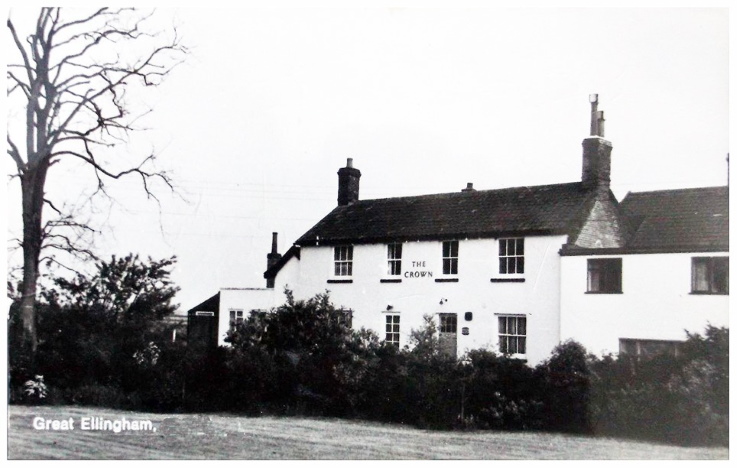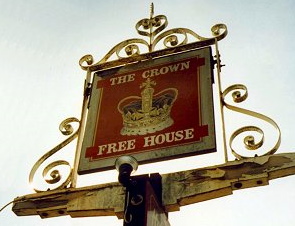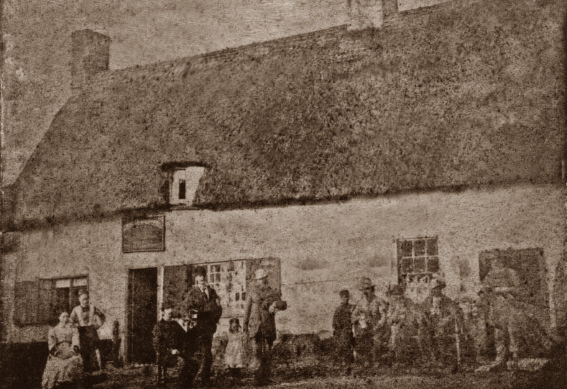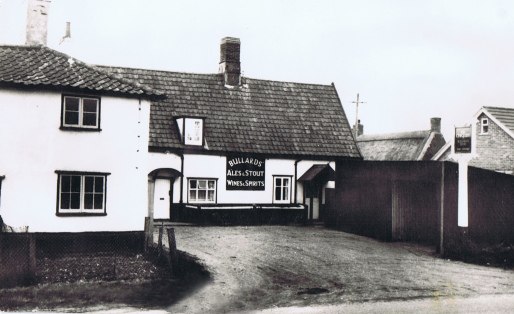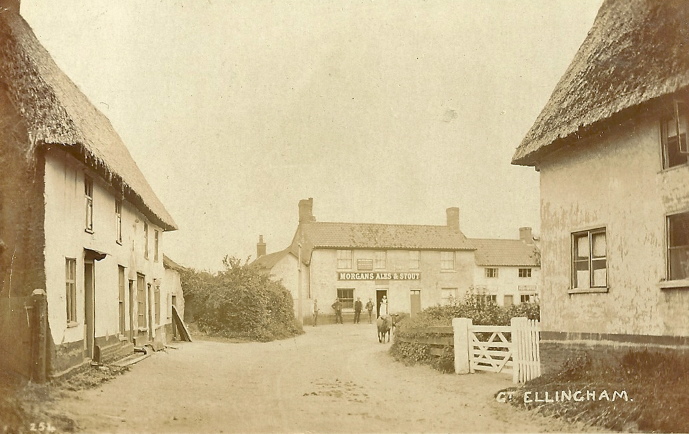
The Crown Public House in the centre. Courtesy of Attleborough Heritage Group
Village pubs have always been a focal point of a community. Great Ellingham is no exception.
During the Victorian period, Great Ellingham had five public houses, some of which were former beer-houses. Today, the village has one remaining pub.
At the end of the working week and, having picked up their hard-earned wages, workers would call into their ‘local’ and spend some of their wages on a pint or two of their ‘usual’ before heading home. No doubt, many would end up the worse for wear by the time they reached home!
Over-indulgence often resulted in rowdy and disorderly behaviour. Local constables would be called upon to break up disturbances which ‘got out of hand’.
On occasions, this led to an appearance before the local Magistrates. Some patrons (for example, the Skipper brothers), stood before the Magistrates on charges of drunk and disorderly behaviour on more than one occasion!
Landlords who failed to ‘keep an orderly house’ would also end up in Court. In 1866, John Brown, the landlord of the Chequers, received a fine for allowing disorderly conduct on his premises.
Pubs also housed auctions, inquests, local meetings and clubs. A ‘Smoking Concert‘ was held at the Crown in April, 1902.
Manorial Courts may also have been held in one (or more) of the pubs.
Many innkeepers also had a trade or other occupation to supplement the income from the pub. Accordingly, most of the day to day running of the pub was left to the wife.
Two Public Houses
At the turn of the eighteenth century, Great Ellingham had two public houses – the Rose & Crown and the Chequers.
Rose & Crown
The Crown Public House. Courtesy of Tony Brooks
This public house was (and still is) in the heart of the village, not far from the parish church.
In 1781, it was known as the Bell. A meeting for landowners of the village was held at the Bell on the 1st September, 1781. Further, historical deeds to the Crown also refer to the pub being previously known as the Bell.
However, by 1787, the property became the Crown. The Times of the 18th May, 1787, reported a ‘terrible fire’ at a house adjoining the Crown in Great Ellingham. The fire destroyed both the house and the pub.
The fire also destroyed much of the stock of the landlord William Jessup’s trade of leather-cutter and shoemaker. The whole incident must have had a huge impact on William Jessup as his property was uninsured!
Consequently, the pub became known as the Rose & Crown. Perhaps the pub was renamed when it was rebuilt after the fire? It was still referred to as the Rose & Crown in 1819. However, by 1836 it was once again known as the Crown.
Cann & Clarke, a local brewery, owned the Crown by 1850. The pub then had a succession of brewery owners and tenant landlords. The last brewery company to own the Crown was Watney Mann.
The sign of the Crown at Great Ellingham. Photograph courtesy of Attleborough Heritage Group
The Crown (now a freehouse) is the only remaining public house in the village.
The Chequers
Chequers Public House during the tenure of Landlord Ellis Carter between 1871 and 1908. Courtesy of Ray Beales
The Chequers was also in the heart of the village, and was on a road which was later aptly named ‘Chequers Lane’.
Owned by the Barnard family from around 1750, the Chequers was sold c.1818 to Shelford Bidwell Esq. Bidwell belonged to the local Thetford brewery company, Bidwell & Co.
The Chequers too had a succession of brewery company owners and tenant landlords.
Blacksmith, Robert Lebbell, was at the Chequers in 1836, and remained there until he took over at the Crown by 1851.
Ellis Carter was probably the longest serving landlord of the Chequers. His tenure began before 1871 and came to an end when he retired over 30 years later in 1908. Ellis Carter was also a farmer.
The Chequers Great Ellingham. Attleborough Heritage Group
The owned by Watney Mann (East Anglia) Limited, the Chequers closed in 1969. It is now a private house.
Home Brewing
Like many other people at this time, some of the villagers brewed their own beer. Predominantly an agricultural community, most of the farmers in Great Ellingham were making their own beer during the 18th and 19th centuries.
Reference to the sale of brewing utensils appears in notices of auctions of premises in Great Ellingham. The auctions usually followed the death or retirement of a farmer or businessman. I have found such notices appearing in local newspapers from at least 1789 to 1863.
Beerhouse Act 1830
Following the Beerhouse Act of 1830, the village had at least two beer-houses.
The Act encouraged the opening of beer-houses in private homes. After obtaining a licence (usually at a nominal fee), a private individual sold their home-brewed beer (which was usually weak and known as ‘small beer’) from a front window or door of their home.
These two beer-houses eventually became public houses – the Queen’s Head and the Currier’s Arms.
The Queen’s Head
White’s Directory of 1836 records Robert Hurst as the keeper of a beer-house in the village. This beer-house later became known as the Queen’s Head.
Robert Hurst’s period of selling beer may have been short. However, the burial registers for St James’s Church record that Robert Hurst lived until he was 105. Perhaps Robert Hurst made an extraordinarily good brew!
Jonathan Rivett is recorded as having a beer-house in 1845. I am unclear as to where Rivett’s beer-house may have been. However, it may well be the same property from which Robert Hurst previously sold his beer.
By 1875, the beer-house became known as the Queen’s Head. At some point, it became brewery owned when it was bought by Bullards. It was closed c.1960.
A Grade II Listed Building, the property is now a private home at the edge of the village.
The Currier’s Arms
By 1845, John Bartram was serving beer from his home along what is now the main road through the village. These premises later became known as the Currier’s Arms (also found as Carrier’s Arms).
1866 was a difficult year for Landlord John Green. Not only was his barn destroyed by fire, but the Magistrates found him guilty of selling beer when he was disqualfied from doing so.
The Currier’s Arms closed before 1900. The premises is now a private house.
The Prince of Wales
The Prince of Wales may have been a purpose-built public house. Standing not far from the Currier’s Arms, this pub was also situated along the main road through the village (towards Rocklands).
Benjamin Lane was granted a new licence in September, 1868.
Harrod’s Directory of 1878 lists Benjamin Lane as a wine, spirit, ale and porter merchant (and cattle dealer) at The Prince of Wales. Accordingly, the income from Lane’s liquor business and cattle dealings supplemented the takings from the pub.
Earlier in 1875, Benjamin Lane charged one of his regulars, Edward Houchen, of being drunk and disorderly and failing to quit his premises. At the hearing at the magistrates court, the bench dismissed the charges. However, Houchen was immediately charged (and convicted) with assaulting Benjamin Lane.
The Prince of Wales had a succession of licensees before it closed c.1917. It is also now a private house.
Off-Licence
The two beer-houses could only sell beer, whereas the Crown and the Chequers (and later, the Prince of Wales) were also able to sell wines, spirits etc.
In addition, the villagers were able to purchase sweet wines from at least one of the grocery shops.
At a General Annual Licensing Meeting for Guiltcross & Shropham on the 9th September, 1873, grocer William Bennett was granted an ‘Off-Licence’. This permitted Bennett to sell ‘sweets’ from his shop in Church Street for consumption off his premises. The ‘sweets’ were not confectionery but sweet wines!
Temperance
During the 19th century, with Great Ellingham having five public houses and at least one shop selling alcoholic drink, it is, perhaps, not surprising to find that the village also had a Temperance Society!
Sources:
The Brewing Industry. A report by the Brewery History Society for English Heritage Febraury 2010
https://historicengland.org.uk/images-books/publications/brewing-industry/bhs-brewing-ind-shier Accessed 26 March 2021
Beer House Act 1830. Wikipedia. https://en.wikipedia.org/wiki/Beerhouse_Act_1830. Accessed 26 March 2021
Norfolk Chronicle 1st September, 1781
Norwich Mercury 16th August, 1873
Norfolk News 17th September, 1864
Norfolk Chronicle 3rd October, 1789. Viewed via British Newspaper Archive https://www.britishnewspaperarchive.co.uk 26th March, 2021
Times, 18 May 1787, p. 3. The Times Digital Archive, https://link.gale.com/apps/doc/CS51119282/TTDA?u=nl_earl&sid=TTDA&xid=49ded6f3. Accessed 11 July 2020.
Norfolk Pubs Website. http://norfolkpubs.co.uk/norfolkg/gtellingham/gtelind.htm Accessed 2nd April, 2021
23rd November 1810. Abstract of Title to the Crown Public House, Great Ellingham. Wymondham Town Archive, Council Offices, Ketts Park, Harts Farm Road, Wymondham NR18 OUT. Reference Pomeroy. ID33827. Box. 116/99. Bundle 8.
1799-1842 F W Horner, Records of the Surveyors to Commissioners for Inclosure in Parishes in Norfolk and Suffolk. Great Ellingham (Act 1799). Norfolk Record Office. Catalogue Ref: NRO, BR 90/2
Great Ellingham Parish Registers. Norfolk Record Office. PD 609. Also available at www.familysearch.org
White’s Directory 1836 Norfolk Record Office
White’s Directory 1845 Norfolk Heritage Centre
Harrod’s Directory 1878 Attleborough Heritage Group
